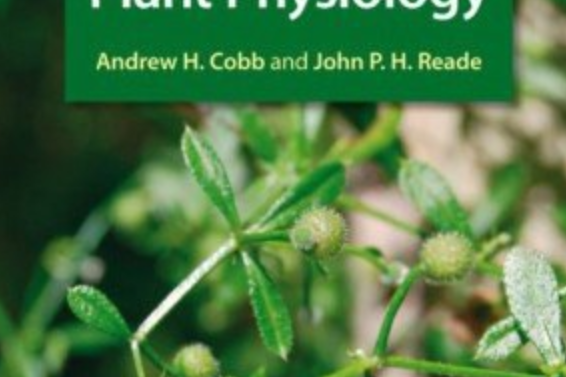《Herbicides and Plant Physiology》是2010年11月John Wiley出版社出版的圖書,作者是Cobb Andrew。
基本介紹
- 外文名:Herbicides and Plant Physiology
- 出版時間:2010年11月
- ISBN:9781405129350
- 定價:590 元
內容簡介,作者簡介,名人推薦,媒體推薦,目錄,
內容簡介
Herbicides continue to make a spectacular contribution to modern safe crop production. It is essential to understand how these compounds work in plants and their surroundings to properly facilitate the development of more effective and safer agrochemicals. This book provides that information in a succinct and user-friendly way. The second edition of this very well-received and highly thought of book has been fully up-dated with much new information of relevance to the subject, particularly in the areas of cell and molecular biology.
作者簡介
Andrew Cobb & John Reade
HarperAdamsUniversityCollege, Shropshire, U. K.
名人推薦
除草劑在現代農業生產中發揮著巨大的作用。為了更有效和更安全地使用除草劑,有必要了解除草劑如何在植物體內發揮作用,並掌握其環境特性。
《除草劑和植物生理學》(第二版)提供了現代除草劑對靶標植物綜合的和最新的報導。本書全面地描述了雜草生物學、雜草和作物的競爭、雜草對作物產量和品質的影響等雜草學知識。講述了除草劑如何用於農業生產、除草劑的發現和發展、除草劑的吸收和代謝、除草劑的選擇性機理等除草劑基礎知識。本書採用植物生理生化分類的方法,系統地介紹了當前除草劑的作用部位和分子靶標,特別詳細地報導了近年來光系統Ⅱ抑制劑、對羥苯基丙酮酸雙氧化酶(HPPD)抑制劑、微管抑制劑、纖維素抑制劑等靶標的最新研究進展。本書還介紹了抗草甘膦、草銨膦、溴苯腈、磺醯脲、2,4-D、八氫番茄紅素脫氫酶抑制劑等轉基因作物,對轉基因植物的發展進行了討論。分析了近年來新除草劑發展緩慢的原因,並探討了未來除草劑的發展。
本書共分為14章。第1章,雜草生物學;第2章,除草劑的發現和發展;第3章,除草劑的吸收和運轉;第4章,除草劑的選擇性和代謝;第5章,抑制光合作用的除草劑;第6章,色素合成抑制劑;第7章,植物激素類除草劑;第8章,類脂合成抑制劑;第9章,胺基酸合成抑制劑;第10章,細胞分裂干擾劑;第11章,纖維素合成抑制劑;第12章,除草劑的抗性;第13章,抗除草劑作物;第14章,除草劑發展的未來靶標。
本書每一章節的後面均附有參考文獻,適合於從事植物生理、植物保護、植物生化、生物技術和農業科學的學生和科研人員閱讀和參考。
——曹坳程 研究員 中國農業科學院植物保護研究所 ——摘自 中國農業科學院《國外農業新書評介》2011年第1期
媒體推薦
"This revised edition of Herbicides and Plant Physiology is an excellent addition to the bookshelf of any advisers, researchers or agronomy students. This authoritative, yet readable resource (first published in 1992) delves beneath the surface of herbicide activity to examine a wide range of past and present weed control strategies and developments from the viewpoint of plant physiology, but also provides a far wider perspective." (Ecclesiastical History, 2011)
目錄
Preface.
1 An Introduction to Weed Biology.
1.1 Introduction.
1.2 Distribution.
1.3 The importance of weeds.
1.4 Problems caused by weeds.
1.5 Biology of weeds.
1.6 A few examples of problem weeds.
1.7 Positive attributes of weeds.
1.8 The ever-changing weed spectrum.
1.9 Weed control.
References.
2 Herbicide Discovery and Development.
2.1 Introduction.
2.2 Markets.
2.3 Prospects.
2.4 Environmental impact and relative toxicology.
2.5 The search for novel active ingredients.
2.6 The search for novel target sites.
2.7 Mode of action studies.
2.8 A lower limit for rates of herbicide application?
References.
3 Herbicide Uptake and Movement.
3.1 Introduction.
3.2 The cuticle as a barrier to foliar uptake.
3.3 Physicochemical aspects of foliar uptake.
3.4 Herbicide formulation.
3.5 Uptake by roots from soil.
3.6 Herbicide translocation from roots to shoots.
3.7 A case study: the formulation of acids.
3.8 Recent developments.
References.
4 Herbicide Selectivity and Metabolism.
4.1 Introduction.
4.2 General principles.
4.3 Herbicide safeners and synergists.
References.
5 Herbicides That Inhibit Photosynthesis.
5.1 Introduction.
5.2 Photosystems.
5.3 Inhibition at Photosystem II.
5.4 Photodamage and repair of Photosystem II.
5.5 Structures and uses of Photosystem II inhibitors.
5.6 Interference with electron flow at Photosystem I.
5.7 RuBisCo activase.
5.8 How treated plants die.
References.
6 Inhibitors of Pigment Biosynthesis.
6.2 Inhibition of chlorophyll biosynthesis.
6.3 Inhibition of carotenoid biosynthesis.
6.4 Inhibition of plastoquinone biosynthesis.
6.5 How treated plants die.
6.6 Selectivity and metabolism.
References.
7 Auxin-Type Herbicides.
7.1 Introduction.
7.2 Structures and uses of auxin-type herbicides.
7.3 Auxin, a natural plant growth regulator.
7.4 Auxin receptors, gene expression and herbicides.
7.5 Signal transduction.
7.6 Auxin transport.
7.7 An ‘auxin’ overdose.
7.8 How treated plants die.
7.9 Selectivity and metabolism.
References.
8 Inhibitors of Lipid Biosynthesis.
8.1 Introduction.
8.2 Structures and uses of graminicides.
8.3 Inhibition of lipid biosynthesis.
8.4 Anti-auxin activity of graminicides.
8.5 How treated plants die.
8.6 Selectivity.
References.
9 The Inhibition of Amino Acid Biosynthesis.
9.1 Introduction.
9.2 Overview of amino acid biosynthesis in plants.
9.3 Inhibition of glutamine synthase.
9.4 Inhibition of EPSP synthase.
9.5 Inhibition of acetolactate synthase.
9.6 Inhibition of histidine biosynthesis.
References.
10 The Disruption of Cell Division.
10.1 Introduction.
10.2 The cell cycle.
10.3 Control of the cell cycle.
10.4 Microtubule structure and function.
10.5 Herbicidal interference with microtubules.
10.6 Selectivity and metabolism.
References.
11 The Inhibition of Cellulose Biosynthesis.
11.1 Introduction.
11.2 Cellulose biosynthesis inhibitors.
11.3 Selectivity and metabolism.
References.
12 Herbicide Resistance.
12.1 Introduction.
12.2 Mechanisms of herbicide resistance.
12.3 How resistance occurs.
12.4 Chronology of herbicide resistance.
12.5 Herbicide resistance case study – black-grass (Alopecurus myosuroides Huds.)
12.6 The future development of herbicide resistance.
References.
13 Herbicide-Tolerant Crops.
13.1 Introduction.
13.2 History of genetically modified, herbicide-tolerant crops.
13.3 How genetically modified crops are produced.
13.4 Genetically engineered herbicide tolerance to glyphosate.
13.5 Genetically modified herbicide tolerance to glufosinate.
13.6 Genetically modified herbicide tolerance to bromoxynil.
13.7 Genetically modified herbicide tolerance to sulfonylureas.
13.8 Genetically modified herbicide tolerance to 2,4-D.
13.9 Genetically modified herbicide tolerance to fops and dims.
13.10 Genetically modified herbicide tolerance to phytoene desaturase.
13.11 Herbicide tolerance due to engineering of enhanced metabolism.
13.12 Herbicide tolerance through means other than genetic modification.
13.13 Genetically modified high-tolerance crops in practice: the UK Farm-Scale Evaluations, 2000–2.
13.14 Future developments.
References.
14 Further Targets For Herbicide Development.
14.1 Introduction.
14.2 Protein turnover.
14.3 Biological control of weeds.
14.4 Natural products as leads for new herbicides.
References.
Glossary.
Index.

